|
| Profiles - Steel Carriers |
| This is another fairly arbitrary categorisation as many of the wagons included are equally capable of carrying other types of load. However, BR has always had a fleet of wagons intended for the carriage of steel ranging from the utilitarian (such as the Bogie Bolster) to the specialised (Trestrol, Slab-Coil, etc). In some cases, the classification was misleading, types such as Plates and Tubes seeing as much use with general merchandise as with their intended loads. Types such as these will be found under both headings were appropriate. |
|
In the TOPS era, this sector has been dominated by railway-owned vehicles including a mix of new designs (such as the BBA) and refurbished older types (BDA). Modifications to carry strip or rod coil are the most common variations. More recently, customers have demanded more protection for their cargos, particularly in the case of ‘bright’ steels, and this has resulted in the development of covered wagons with either canvas (BGA, JSA) or sliding hoods (BRA, BXA, JSA). RIV steel wagons have had these features for many years. |
|
| Image |
Type |
Built |
Qty |
Used |
Added |
Edited |
|
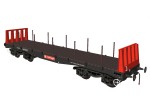 |
BAA Bogie Steel Wagons |
1972-1976 |
305 |
1972-current |
22/12/2007 |
30/09/2008 |
|
When the initial examples appeared in 1972, the BAA wagons were the first bogie steel wagons built new for BR in 10 years. The design was a radical departure from earlier types, with modern bogies and sturdy ends. Just over 300 were built over the next four years, production then switching to the larger BBA type. In its basic form the type was able to carry a range of loads including slabs, ingots and strip coil. Many were later modified for steel coil traffic and the majority remain in service.
|
|
 |
BBA Bogie Steel Wagons |
1973-1981 |
551 |
1973-current |
1/12/2006 |
24/12/2006 |
|
The BBA and similar but shorter BAA have been the mainstay of the heavy steel carrying fleet since their introduction in the mid-1970s. The basic design was able to carry ingots, slabs and coils, but many were later modified to suit a particular traffic.
|
|
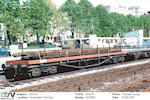 |
BCA/BDA Air-Braked Bogie Bolsters  |
1975-1981 |
1253 |
1975-current |
16/12/2007 |
10/05/2015 |
|
Over 1000 Bogie Bolster wagons were refurbished by BR in the 1970s with new bogies and air brakes. Most were 52ft long Bogie Bolster Ds, which became BDAs, but two Cs were also rebuilt, becoming the short-lived BCAs. A large proportion of the BDAs remain in service today, many having undergone modification for specific duties.
|
|
 |
Air-Braked Bogie Steel Prototypes |
1976-1990 |
14 |
1976-current |
23/12/2007 |
10/05/2015 |
|
Five types of bogie steel wagon were built between 1976 and 1990, none of which entered serial production. First was the BLA of 1976 (a stretched BBA), then the YXA of 1985 (built to test new bogies). Finally the BGA/BHA/BJA family of 1990, a concerted effort to find replacements for the ageing BDA fleet as well as to provide better protection for steel loads. |
|
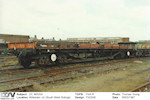 |
BPA/BRA/BXA Bogie Steel Rebuilds |
1979-1982 |
281 |
1977-current |
22/12/2007 |
16/03/2010 |
|
As well as a large number of Bogie Bolsters, three other types of bogie steel wagon received overhauls in the late 1970s and early 1980s. 51 Trestles, 80 Boplates and 150 Borails were fitted with air brakes and new bogies and recoded XVA, BPA and BRA respectively. As with many air-braked types, all three had very short lives in their initial roles. Transfers to the departmental fleet and modifications for alternate uses affected all 281 wagons and a wide range of TOPS codes have been applied. Despite their age, just over 200 wagons were still in stock in early 2008. |
|
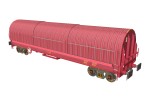 |
BRA/BYA Covered Steel Wagons |
1998-1999 |
310 |
1998-current |
22/12/2007 |
02/07/2008 |
|
The BRA and BYA covered steel wagons were the first to be built by Thrall Europa at the reopened York Works. Part of EWS's plan to rejuvenate the wagon fleet, the two very similar types were also intended to address the growing need to provide better protection to loads of finished steel. Their rather curious appearance, with a round-topped hood made of corrugated steel, earned them the nickname of Nissen Huts and they were soon to be found on steel trains across the country.
|
|
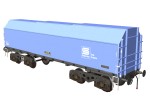 |
JSA Covered Steel Wagons |
1996/2007 |
84 |
1996-current |
1/10/2007 |
15/12/2007 |
|
The need to keep finished steel in good condition for customers has seen an increase in the number of covered steel carriers in the UK. This profile details the wagons converted from Iron-ore tipplers in the late 1990s.
|
|
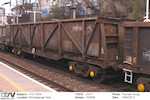 |
PX030 Sheerness Steel Bogie Steel/Scrap Wagons  |
1974 |
8 |
1974-current |
01/01/2008 |
12/04/2008 |
|
Although only 8 were built, these wagons were of interest in being among the first modern private-owner bogie steel wagons. In appearance they were similar to the BR-built BBA wagons but with higher ends. After just a few years service they were rebuilt as open wagons for carrying scrap metal, a role in which they continued following the end of traffic to Sheerness. A transfer to infrastructure duties was shortlived, having resulted in the derailment and withdrawal of 3 of the class.
|
|
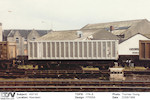 |
SAA Steel Carriers / FPA Container Flats  |
1966-1971 |
301 |
1966-current |
1/12/2006 |
10/01/2008 |
|
The SAA fleet of 2-axle steel carrying wagons had a very short life in their original form, and the majority saw extensive use as barriers and runners. After 10 years of under utilisation, over half of the wagons were rebuilt as FPA container flats and were used to carry coal, mainly in Scotland.
|
|
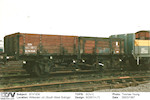 |
SOV/ODA Pipe Wagons  |
1949-1958 |
1950 |
1949-current |
16/12/2007 |
16/12/2007 |
|
Almost 2000 pipe wagons were built by BR, over half of which were vacuum fitted from new. This ensured the survival of many examples until fairly recently. 50 wagons were rebuilt with air brakes in 1983 as ODAs, primarily for MoD use, while many others were transferred to departmental use.
|
|
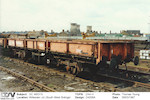 |
SPA Plate Wagons  |
1977-1981 |
1102 |
1977-current |
22/12/2007 |
28/12/2007 |
|
Following the conversion of two SAA steel wagons into SPA plate wagons in 1977, a production run of 1100 new-build SPAs was authorised. Further batches totalling 600 wagons were cancelled before work started. Although designated as a steel plate carrier, the type found a wide variety of uses including loads as diverse as army vehicles and rod coil. As with many of the air-braked types, there have been many subsequent modifications, both for revenue and departmental uses.
|
|
 |
STV Tube Wagons |
1949-1961 |
3460 |
1949-current |
01/01/2008 |
26/06/2008 |
|
Ask a wagon enthusiast what is longer, a pipe or a tube and they will tell you it is the latter! Both Pipe and Tube were well-established wagon types by the time BR was formed in 1948, and many more were built over the next 14 years. As with the shorter Pipe wagons, the Tubes survived in some numbers into the 1980s, thanks to the vacuum brakes fitted to many. By the 1990s, only departmental wagons remained, although these included some of the earliest built by BR. The last few Tubes were withdrawn in about 2007.
|
|
|

















